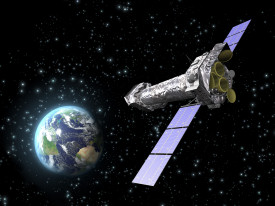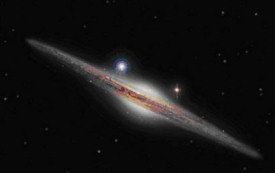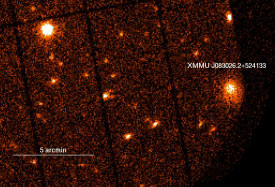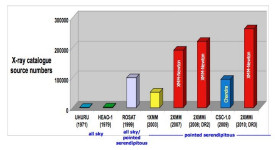XMM-Newton releases new edition of cosmic catalogue
28 April 2010
One of the teams behind ESA's XMM-Newton X-ray mission has unveiled the latest edition of their 2XMM catalogue. The newest incarnation boasts an additional 42 000 entries, ratcheting up the total to over a quarter of a million X-ray sources. This unprecedented cosmic X-ray library is a valuable resource allowing astronomers to explore the extreme Universe.
 |
| The XMM-Newton spacecraft. Credit: ESA |
This latest edition of the 2XMM catalogue, an unrivalled storehouse of information on X-ray sources, is the largest ever assembled. It is constructed through the serendipitous data acquired whilst piggy-backing on XMM-Newton's normal observing programme, which is based on competitive bids from the astronomical community. XMM-Newton makes over 600 observations each year but the target object typically only takes up a tiny fraction of the field of view of 30 arc minutes, equivalent to the diameter of the full Moon. Keen not to waste such an opportunity, the images are also searched for additional X-ray sources, with the findings being accumulated in the 2XMM catalogue for future reference. On average, an extra seventy sources additional to the main object of interest are found.
"We are getting
 |
| An intermediate-mass black hole (shown here above and to the left of the galactic bulge) was discovered in the 2XMM catalogue. Credit: Heidi Sagerud |
Amongst the many surprises that have emerged from the 2XMM catalogue is the chance discovery, in 2009, of a variable hyper-luminous X-ray source, 2XMM J011028.1-460421, also known as HLX-1. Weighing in at a hefty 500 solar masses, HLX-1 shows all the signs of being an intermediate-mass black hole, the missing link between stellar-mass and supermassive black holes. While it is accepted that stellar-mass black holes are the remnants of massive stars, the formation process for supermassive black holes is still unclear, although a number of explanations have been proposed, amongst them one scenario that involves mergers of intermediate-mass black holes. This XMM-Newton detection was the first solid evidence that such an intermediate class exists.
 |
| A massive galaxy cluster discovered in the 2XMM catalogue. Credit: ESA XMM-Newton/EPIC (G. Lamer) |
Another serendipitous discovery, made in 2008, was the detection of the most massive galaxy cluster found up to that point in the distant Universe. The heavyweight, known by its catalogue number, 2XMM J083026+524133, tipped the scales at roughly 5 × 1014 solar masses, equivalent to the combined mass of over a thousand large galaxies. The discovery also lent weight to the growing evidence for dark energy, the force attributed to the observed expansion of the Universe. XMM-Newton is particularly well suited to this probing of the early, far-off Universe because of its large collecting area.
A continually enhanced 2XMM catalogue also allows astronomers to compare X-ray data with other large catalogues in other wavebands. In doing so, they can spot classes of objects which either don't show up or behave radically differently at other wavelengths. "One productive approach is simply to look for rare objects. You can do that by finding X-ray sources which have very peculiar properties when you start looking at what you find at other wavelengths," said Watson. Some of the rarest types of Active Galactic Nuclei (AGNs), quasars and X-ray binaries are just some of the unusual objects unmasked by 2XMM catalogue data.
 |
|
X-ray source catalogues. Image courtesy of M. Watson, University of Leicester |
Passing the milestone of a quarter of a million sources is something that Watson believes will allow astronomers to build on these previous successes. "The catalogue is now big enough that it really does provide a very good solid basis for exploring the cosmic X-ray source population," he said. And far from resting on their laurels the XMM-Newton team hope to continue to increase their catalogue. "As the catalogue gets bigger it has more and more potential. At the current rate we'll reach half a million catalogued X-ray sources in the next five or six years," Watson added.
Schartel also recognises the need to continue with building the catalogue despite a decade of success. "The 2XMM catalogue is still, even after 10 years, producing exciting new results. It is also a key catalogue for future missions to optimise their target choices for future research. So catalogues such as this have a legacy that goes much further into the future than just current research," he said.
For further details please contact:
Mike Watson, XMM-Newton Survey Scientist
Department of Physics & Astronomy,
University of Leicester, United Kingdom
Email: mgw star.le.ac.uk
star.le.ac.uk
Norbert Schartel, ESA XMM-Newton Project Scientist
European Space Astronomy Centre, Spain
Email: Norbert.Schartel sciops.esa.int
sciops.esa.int
Notes for editors
This latest release of the 2XMM catalogue, referred to as 2XMMi-DR3, contains source detections drawn from 4953 observations made with XMM-Newton's European Photon Imaging Cameras (EPIC) between February 2000 and October 2009. The catalogue contains
The XMM-Newton Survey Science Centre, led by Professor Mike Watson at the University of Leicester, is a consortium of the following institutions:
University of Leicester, United Kingdom
Mullard Space Science Laboratory, University College London, United Kingdom
Institute of Astronomy, Cambridge, United Kingdom
Max-Planck Institut für extraterrestrische Physik, Garching, Germany
Astrophysikalisches Institut, Potsdam, Germany
Service d'Astrophysique, CEA/DSM/Dapnia, Saclay, France
Centre d'Etude Spatiale des Rayonnements, Toulouse, France
Observatoire Astronomique de Strasbourg, France
Instituto de Fisica de Cantabria, Santander, Spain
Osservatorio Astronomico di Brera, Milan, Italy


